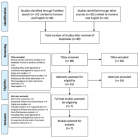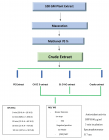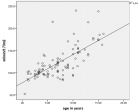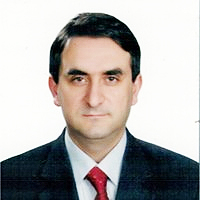Abstract
Review Article
The role of UK national ligament registry as additional source of evidence for anterior cruciate ligament reconstruction: Review of the literature and future Perspectives
Tarek Boutefnouchet*, Thomas Laios and Keshav Mathur
Published: 20 August, 2017 | Volume 2 - Issue 3 | Pages: 081-090
Background: There is paucity in studies reporting long-term results following anterior cruciate ligament (ACL) rupture. A UK national ligament registry (NLR) designed to collect demographic, clinical and outcome data on patients undergoing ACL reconstruction was launched in 2013. There was therefore an emergent question on the role of such registry as an additional source of evidence.
Study aims: A framework analysis aimed to provide a basis for the evaluation of outcomes following ACL management and formulate a structure of the evidence, which can be derived from the registry.
Methods: A systematic approach was adopted to select relevant studies. Qualitative thematic and meta-narrative analyses were conducted. Level-1 registry data were recorded for all primary ACL reconstruction procedures from January to June 2016. Registry data content and validity were evaluated.
Results: Seven studies were suitable for analyses yet none defined the pattern of meniscal injury following initial treatment. When reported the incidence varied markedly between 23% and 80%. There was evidence of collection of at least one principal outcome measure in at least 85% of participants across all studies. Thematic analysis identified four key domains of outcome measures (1) intervention selection, (2) Knee stability evaluation, (3) Patient reported outcomes, (4) Radiographic evaluation and risk of secondary osteoarthritis. Graft choice, rate of meniscal and chondral injuries and cumulative risk of revision surgery had incomplete and inconsistent reports. Comparison of demographic and clinical data with the first registry report demonstrated: predominately younger patient population; older female patients at time of intervention; and higher incidence of meniscal tears.
Conclusions: Registry data driven quality and research improvement open a new paradigm in ACL reconstruction evidence base and future practice. Early observations have consolidated the importance of associated meniscal injuries in the management of ACL rupture. Further work is needed to improve registry data completeness, accuracy and validity. A proposed data migration process using available technologies can help harmonise data collection without the added burden on clinical services.
Read Full Article HTML DOI: 10.29328/journal.jsmt.1001012 Cite this Article Read Full Article PDF
Keywords:
Anterior cruciate ligament; Surgical management; Physiotherapy; Clinical decision-making; Clinical Registry; Cost-effectiveness
References
- Linko E, Harilainen A, Malmivaara A, Seitsalo S. Surgical versus conservative interventions for anterior cruciate ligament ruptures in adults. Cochrane Database Syst Rev. 2005. Ref.: https://goo.gl/fwqQD6
- Kwok CS, Harrison T, Servant C. The optimal timing for anterior cruciate ligament reconstruction with respect to the risk of postoperative stiffness. Arthroscopy. 2013; 29: 556-565. Ref.: https://goo.gl/p3Hzfk
- Smith TO, Davies L, Hing CB. Early versus delayed surgery for anterior cruciate ligament reconstruction: a systematic review and meta-analysis. Knee Surg Sports Traumatol Arthrosc. 2010; 18: 304-311. Ref.: https://goo.gl/rJMNKN
- Mather RC 3rd, Koenig L, Kocher MS, Dall TM, Gallo P, et al. Societal and economic impact of anterior cruciate ligament tears. J Bone Joint Surg Am. 2013; 95: 1751-1759. Ref.: https://goo.gl/k25ZnU
- Chalmers PN, Mall NA, Moric M, Sherman SL, Paletta GP, et al. Does ACL reconstruction alter natural history?: A systematic literature review of long-term outcomes. J Bone Joint Surg Am. 2014; 96: 292-300. Ref.: https://goo.gl/1DSZpt
- Kapoor B, Clement DJ, Kirkley A, Maffulli N. Current practice in the management of anterior cruciate ligament injuries in the United Kingdom. Br J Sports Med. 2004; 38: 542-544. Ref.: https://goo.gl/r9mJnu
- Nordenvall R, Bahmanyar S, Adami J, Mattila VM, Felländer-Tsai L. Cruciate ligament reconstruction and risk of knee osteoarthritis: the association between cruciate ligament injury and post-traumatic osteoarthritis. a population based nationwide study in Sweden, 1987-2009. PLoS One. 2014; 9. Ref.: https://goo.gl/HazmXG
- Lohmander LS, Roos EM. The evidence base for orthopaedics and sports medicine. Bmj. 2015; 350. Ref.: https://goo.gl/yHSzek
- Frobell RB, Roos EM, Roos HP, Ranstam J, Lohmander LS. A randomized trial of treatment for acute anterior cruciate ligament tears. N Engl J Med. 2010; 363: 331-342. Ref.: https://goo.gl/pFrWgW
- Levy BA. Is early reconstruction necessary for all anterior cruciate ligament tears? N Engl J Med. 2010; 363: 386-388. Ref.: https://goo.gl/H51jXb
- Richmond JC, Lubowitz JH, Poehling GG. Prompt operative intervention reduces long-term osteoarthritis after knee anterior cruciate ligament tear. Arthroscopy. 2011: 27: 149-52. Ref.: https://goo.gl/XSBfDP
- Sri-Ram K, Salmon LJ, Pinczewski LA, Roe JP. The incidence of secondary pathology after anterior cruciate ligament rupture in 5086 patients requiring ligament reconstruction. Bone Joint J. 2013; 95: 59-64. Ref.: https://goo.gl/fCDPBf
- Dwan K, Gamble C, Williamson PR, Kirkham JJ, Reporting Bias Group. Systematic review of the empirical evidence of study publication bias and outcome reporting bias - an updated review. PLoS One. 2013; 8. Ref.: https://goo.gl/GWyCbr
- Chan AW, Song F, Vickers A, Jefferson T, Dickersin K, et al. Increasing value and reducing waste: addressing inaccessible research. Lancet. 2014; 383: 257-266. Ref.: https://goo.gl/vFjpZ5
- Chan AW, Krleza-Jeric K, Schmid I, Altman DG. Outcome reporting bias in randomized trials funded by the Canadian Institutes of Health Research. Cmaj. 2004; 171: 735-740. Ref.: https://goo.gl/eg5JuL
- Shamliyan T, Kane RL. Clinical research involving children: registration, completeness, and publication. Pediatrics. 2012; 129. Ref.: https://goo.gl/M3wRqn
- Bourgeois FT, Murthy S, Mandl KD. Outcome reporting among drug trials registered in ClinicalTrials.gov. Ann Intern Med. 2010; 153: 158-166. Ref.: https://goo.gl/NtXx3X
- Turner EH, Matthews AM, Linardatos E, Tell RA, Rosenthal R. Selective publication of antidepressant trials and its influence on apparent efficacy. N Engl J Med. 2008; 358: 252-260. Ref.: https://goo.gl/5DcFXT
- Chalmers I. Underreporting research is scientific misconduct. Jama. 1990; 263: 1405-1408. Ref.: https://goo.gl/9c1q2c
- Smyth RM, Kirkham JJ, Jacoby A, Altman DG, Gamble C, et al. Frequency and reasons for outcome reporting bias in clinical trials: interviews with trialists. Bmj. 2011; 342. Ref.: https://goo.gl/fypysz
- Saini P, Loke YK, Gamble C, Altman DG, Williamson PR, et al. Selective reporting bias of harm outcomes within studies: findings from a cohort of systematic reviews. Bmj. 2014; 349. Ref.: https://goo.gl/38qTuY
- Makhni EC, Padaki AS, Petridis PD, Steinhaus ME, Ahmad CS, et al. High Variability in Outcome Reporting Patterns in High-Impact ACL Literature. J Bone Joint Surg Am. 2015; 97: 1529-1542. Ref.: https://goo.gl/1hy5ka
- Frobell RB, Roos HP, Roos EM, Roemer FW, Ranstam J, et al. Treatment for acute anterior cruciate ligament tear: five year outcome of randomised trial. Bmj. 2013; 346. Ref.: https://goo.gl/qxC93j
- Meuffels DE, Favejee MM, Vissers MM, Heijboer MP, Reijman M, et al. Ten year follow-up study comparing conservative versus operative treatment of anterior cruciate ligament ruptures. A matched-pair analysis of high level athletes. Br J Sports Med. 2009; 43: 347-351. Ref.: https://goo.gl/T82rB5
- Swirtun LR, Renstrom P. Factors affecting outcome after anterior cruciate ligament injury: a prospective study with a six-year follow-up. Scand J Med Sci Sports. 2008; 18: 318-324. Ref.: https://goo.gl/zZgNQV
- Kessler MA, Behrend H, Henz S, Stutz G, Rukavina A, et al. Function, osteoarthritis and activity after ACL-rupture: 11 years follow-up results of conservative versus reconstructive treatment. Knee Surg Sports Traumatol Arthrosc. 2008; 16: 442-448. Ref.: https://goo.gl/ycJ2H8
- Fink C, Hoser C, Hackl W, Navarro RA, Benedetto KP. Long-term outcome of operative or nonoperative treatment of anterior cruciate ligament rupture--is sports activity a determining variable? Int J Sports Med. 2001; 22: 304-309. Ref.: https://goo.gl/FEJPX8
- Mihelic R, Jurdana H, Jotanovic Z, Madjarevic T, Tudor A. Long-term results of anterior cruciate ligament reconstruction: A comparison with non-operative treatment with a follow-up of 17-20 years. International Orthopaedics. 2011; 35: 1093-1097. Ref.: https://goo.gl/2ciqy8
- Poolman RW, Struijs PA, Krips R, Sierevelt IN, Marti RK, et al. Reporting of outcomes in orthopaedic randomized trials: does blinding of outcome assessors matter? J Bone Joint Surg Am. 2007; 89: 550-558. Ref.: https://goo.gl/9QQ8hr
- Hrobjartsson A, Thomsen AS, Emanuelsson F, Tendal B, Rasmussen JV, et al. Observer bias in randomized clinical trials with time-to-event outcomes: systematic review of trials with both blinded and non-blinded outcome assessors. Int J Epidemiol. 2014; 43: 937-948. Ref.: https://goo.gl/EMMto8
- Smith TO, Postle K, Penny F, McNamara I, Mann CJ. Is reconstruction the best management strategy for anterior cruciate ligament rupture? A systematic review and meta-analysis comparing anterior cruciate ligament reconstruction versus non-operative treatment. Knee. 2014; 21: 462-470. Ref.: https://goo.gl/LD7vEQ
- Streich NA, Zimmermann D, Bode G, Schmitt H. Reconstructive versus non-reconstructive treatment of anterior cruciate ligament insufficiency. A retrospective matched-pair long-term follow-up. Int Orthop. 2011; 35: 607-613. Ref.: https://goo.gl/YBGcy4
- Kvist J, Kartus J, Karlsson J, Forssblad M. Results from the Swedish national anterior cruciate ligament register. Arthroscopy. 2014; 30: 803-810. Ref.: https://goo.gl/1UcyMw
- Ahlden M, Samuelsson K, Sernert N, Forssblad M, Karlsson J, et al. The Swedish National Anterior Cruciate Ligament Register: a report on baseline variables and outcomes of surgery for almost 18,000 patients. Am J Sports Med. 2012; 40: 2230-2235. Ref.: https://goo.gl/1y1F4t
- Lynch TS, Parker RD, Patel RM, Andrish JT, MOON Group, et al. The Impact of the Multicenter Orthopaedic Outcomes Network (MOON) Research on Anterior Cruciate Ligament Reconstruction and Orthopaedic Practice. J Am Acad Orthop Surg. 2015; 23: 154-163. Ref.: https://goo.gl/72ZgNE
- Mather RC, 3rd, Hettrich CM, Dunn WR, Cole BJ, Bach BR Jr, et al. Cost-Effectiveness Analysis of Early Reconstruction Versus Rehabilitation and Delayed Reconstruction for Anterior Cruciate Ligament Tears. Am J Sports Med. 2014; 42: 1583-1591. Ref.: https://goo.gl/kWLd6y
- Fithian DC, Paxton EW, Stone ML, Luetzow WF, Csintalan RP, et al. Prospective trial of a treatment algorithm for the management of the anterior cruciate ligament-injured knee. Am J Sports Med. 2005; 33: 335-346. Ref.: https://goo.gl/cJpDHv
- Fithian DC. To Operate or Not to Operate? That Is (Still) the Question: Commentary on an article by Hege Grindem, PT, PhD, et al.: "Nonsurgical or Surgical Treatment of ACL Injuries: Knee Function, Sports Participation, and Knee Reinjury. The Delaware-Oslo ACL Cohort Study". J Bone Joint Surg Am. 2014; 96. Ref.: https://goo.gl/eTVCVi
- Grindem H, Eitzen I, Engebretsen L, Snyder-Mackler L, Risberg MA. Nonsurgical or Surgical Treatment of ACL Injuries: Knee Function, Sports Participation, and Knee Reinjury: The Delaware-Oslo ACL Cohort Study. J Bone Joint Surg Am. 2014; 96: 1233-1241. Ref.: https://goo.gl/Lkb7QP
- Hurd WJ, Axe MJ, Snyder-Mackler L. A 10-year prospective trial of a patient management algorithm and screening examination for highly active individuals with anterior cruciate ligament injury: Part 1, outcomes. Am J Sports Med. 2008; 36: 40-47. Ref.: https://goo.gl/6RyHXt
- Bray RC, Dandy DJ. Meniscal lesions and chronic anterior cruciate ligament deficiency. Meniscal tears occurring before and after reconstruction. J Bone Joint Surg Br. 1989; 71: 128-130. Ref.: https://goo.gl/aYQiEU
- Robb C, Kempshall P, Getgood A, Standell H, Sprowson A, et al. Meniscal integrity predicts laxity of anterior cruciate ligament reconstruction. Knee Surg Sports Traumatol Arthrosc. 2015; 23: 3683-3690. Ref.: https://goo.gl/KqehRu
- Fetzer GB, Spindler KP, Amendola A, Andrish JT, Bergfeld JA, et al. Potential market for new meniscus repair strategies: evaluation of the MOON cohort. J Knee Surg. 2009; 22: 180-186. Ref.: https://goo.gl/rERJNz
- Jameson SS, Dowen D, James P, Serrano-Pedraza I, Reed MR, et al. Complications following anterior cruciate ligament reconstruction in the English NHS. Knee. 2012; 19: 14-19. Ref.: https://goo.gl/unDQmb
- Tibor L, Chan PH, Funahashi TT, Wyatt R, Maletis GB, et al. Surgical Technique Trends in Primary ACL Reconstruction from 2007 to 2014. J Bone Joint Surg Am. 2016; 98: 1079-1089. Ref.: https://goo.gl/YEjsgx
- Duffee A, Magnussen RA, Pedroza AD, Flanigan DC, MOON Group, et al. Transtibial ACL femoral tunnel preparation increases odds of repeat ipsilateral knee surgery. J Bone Joint Surg Am. 2013; 95: 2035-2042. Ref.: https://goo.gl/XuVKN5
- Rahr-Wagner L, Thillemann TM, Pedersen AB, Lind M. Comparison of hamstring tendon and patellar tendon grafts in anterior cruciate ligament reconstruction in a nationwide population-based cohort study: results from the danish registry of knee ligament reconstruction. Am J Sports Med. 2014; 42: 278-284. Ref.: https://goo.gl/bUAVKD
- Sabah SA, Henckel J, Cook E, Whittaker R, Hothi H, et al. Validation of primary metal-on-metal hip arthroplasties on the National Joint Registry for England, Wales and Northern Ireland using data from the London Implant Retrieval Centre: a study using the NJR dataset. Bone Joint J. 2015; 97: 10-18. Ref.: https://goo.gl/NqNh97
- Gundtoft PH, Pedersen AB, Schonheyder HC, Overgaard S. Validation of the diagnosis 'prosthetic joint infection' in the Danish Hip Arthroplasty Register. Bone Joint J. 2016; 98: 320-325. Ref.: https://goo.gl/hfrD5S
- Samuel AM, Lukasiewicz AM, Webb ML, Bohl DD, Basques BA, et al. Do we really know our patient population in database research? A comparison of the femoral shaft fracture patient populations in three commonly used national databases. Bone Joint J. 2016; 98: 425-432. Ref.: https://goo.gl/VfnBvU
- Atherton H, Sawmynaden P, Sheikh A, Majeed A, Car J. Email for clinical communication between patients/caregivers and healthcare professionals. Cochrane Database Syst Rev. 2012; 11. Ref.: https://goo.gl/zN8pYT
- Haun JN, Patel NR, Lind JD, Antinori N. Large-Scale Survey Findings Inform Patients' Experiences in Using Secure Messaging to Engage in Patient-Provider Communication and Self-Care Management: A Quantitative Assessment. J Med Internet Res. 2015; 17. Ref.: https://goo.gl/yhH19w
- National Joint Registry: Supporting Data Quality. 2016.
Figures:

Figure 1
Similar Articles
-
3-Dimensional Versus 2-Dimensional Comparison of Knee Valgus Collapse during Vertical Jump: Clinical Implications for ACL Risk of Injury AssessmentGuilherme M Cesar*,Chase M Pfeifer,Judith M Burnfield. 3-Dimensional Versus 2-Dimensional Comparison of Knee Valgus Collapse during Vertical Jump: Clinical Implications for ACL Risk of Injury Assessment. . 2017 doi: 10.29328/journal.jsmt.1001006; 2: 032-038
-
The role of UK national ligament registry as additional source of evidence for anterior cruciate ligament reconstruction: Review of the literature and future PerspectivesTarek Boutefnouchet*,Thomas Laios,Keshav Mathur. The role of UK national ligament registry as additional source of evidence for anterior cruciate ligament reconstruction: Review of the literature and future Perspectives. . 2017 doi: 10.29328/journal.jsmt.1001012; 2: 081-090
-
The effects of physiotherapy and rehabilitation on Pallister-Killian Syndrome: A case reportZehra Guchan Topcu*,Selma Uzuner. The effects of physiotherapy and rehabilitation on Pallister-Killian Syndrome: A case report. . 2018 doi: 10.29328/journal.jsmt.1001035; 3: 118-123
-
Difference in Injury Risk between Male and Female Alpine Skiers: Review of the LiteratureBrittany Ammerman*, Margot Richards, Ryann Davie, Natalie Pahapill, Karen Sutton. Difference in Injury Risk between Male and Female Alpine Skiers: Review of the Literature. . 2024 doi: 10.29328/journal.jsmt.1001075; 9: 011-014
-
Effects of Physiotherapy Care in the Postoperative of Total Hip Arthroplasty: An Integrative ReviewWeslley Barbosa Sales*, Rômulo Claudino Sales e Rodrigues Costa, José Vinicius Bulhões da Silva. Effects of Physiotherapy Care in the Postoperative of Total Hip Arthroplasty: An Integrative Review. . 2024 doi: 10.29328/journal.jsmt.1001077; 9: 022-026
-
Exploring Dermatofunctional Perspectives beyond Aesthetics: An Integrative Literature ReviewTatiane Franco, Weslley Barbosa Sales*, José Vinicius Bulhões da Silva, Djavan Gomes Leite, Giovanna Pontes Pina Vidal. Exploring Dermatofunctional Perspectives beyond Aesthetics: An Integrative Literature Review. . 2024 doi: 10.29328/journal.jsmt.1001078; 9: 027-031
-
Effects of Physical Therapy in The Postoperative Period of Plastic Surgery: An Integrative ReviewJoanna Viana Cacho Neta, Weslley Barbosa Sales*, José Vinicius Bulhões da Silva, Giovanna Pontes Pina Vidal. Effects of Physical Therapy in The Postoperative Period of Plastic Surgery: An Integrative Review. . 2024 doi: 10.29328/journal.jsmt.1001079; 9: 032-036
Recently Viewed
-
FITT-CORRECT: Updated dynamic and evidence-based principle of exercise prescriptionShambhu P Adhikari*,Jarugool Tretriluxana,Rubee Dev,Emily Eglitis,Nistha Shrestha,Cheryl Kerfeld6. FITT-CORRECT: Updated dynamic and evidence-based principle of exercise prescription. J Nov Physiother Rehabil. 2021: doi: 10.29328/journal.jnpr.1001039; 5: 005-009
-
Unusual cause of parietal thoracic pain: A case reportMohamed Labied*,Hayat Lhajoui,Najwa Touil,Omar Kacimi,Nabil Chikhaoui . Unusual cause of parietal thoracic pain: A case report. Arch Case Rep. 2020: doi: 10.29328/journal.acr.1001040; 4: 046-047
-
Zn2+ Ions-Immune Virucidal activities for children and adults with preventions against 2019-nCoV and COVID-19 infectionTsuneo Ishida*. Zn2+ Ions-Immune Virucidal activities for children and adults with preventions against 2019-nCoV and COVID-19 infection. J Child Adult Vaccines Immunol. 2020: doi: 10.29328/journal.jcavi.1001006; 4: 006-014
-
Exophthalmos Revealing a Spheno Temporo Orbital MeningiomaHassina S*, Krichene MA, Hazil Z, Bekkar B, Hasnaoui I, Robbana L, Bardi S, Akkanour Y, Serghini L, Abdallah EL. Exophthalmos Revealing a Spheno Temporo Orbital Meningioma. Int J Clin Exp Ophthalmol. 2024: doi: 10.29328/journal.ijceo.1001055; 8: 001-003
-
Unveiling the Impostor: Pulmonary Embolism Presenting as Pneumonia: A Case Report and Literature ReviewSaahil Kumar,Karuna Sree Alwa*,Mahesh Babu Vemuri,Anumola Gandhi Ganesh Gupta,Nuthan Vallapudasu,Sunitha Geddada. Unveiling the Impostor: Pulmonary Embolism Presenting as Pneumonia: A Case Report and Literature Review. J Pulmonol Respir Res. 2025: doi: 10.29328/journal.jprr.1001065; 9: 001-005
Most Viewed
-
Evaluation of Biostimulants Based on Recovered Protein Hydrolysates from Animal By-products as Plant Growth EnhancersH Pérez-Aguilar*, M Lacruz-Asaro, F Arán-Ais. Evaluation of Biostimulants Based on Recovered Protein Hydrolysates from Animal By-products as Plant Growth Enhancers. J Plant Sci Phytopathol. 2023 doi: 10.29328/journal.jpsp.1001104; 7: 042-047
-
Sinonasal Myxoma Extending into the Orbit in a 4-Year Old: A Case PresentationJulian A Purrinos*, Ramzi Younis. Sinonasal Myxoma Extending into the Orbit in a 4-Year Old: A Case Presentation. Arch Case Rep. 2024 doi: 10.29328/journal.acr.1001099; 8: 075-077
-
Feasibility study of magnetic sensing for detecting single-neuron action potentialsDenis Tonini,Kai Wu,Renata Saha,Jian-Ping Wang*. Feasibility study of magnetic sensing for detecting single-neuron action potentials. Ann Biomed Sci Eng. 2022 doi: 10.29328/journal.abse.1001018; 6: 019-029
-
Physical activity can change the physiological and psychological circumstances during COVID-19 pandemic: A narrative reviewKhashayar Maroufi*. Physical activity can change the physiological and psychological circumstances during COVID-19 pandemic: A narrative review. J Sports Med Ther. 2021 doi: 10.29328/journal.jsmt.1001051; 6: 001-007
-
Pediatric Dysgerminoma: Unveiling a Rare Ovarian TumorFaten Limaiem*, Khalil Saffar, Ahmed Halouani. Pediatric Dysgerminoma: Unveiling a Rare Ovarian Tumor. Arch Case Rep. 2024 doi: 10.29328/journal.acr.1001087; 8: 010-013

HSPI: We're glad you're here. Please click "create a new Query" if you are a new visitor to our website and need further information from us.
If you are already a member of our network and need to keep track of any developments regarding a question you have already submitted, click "take me to my Query."
























































































































































